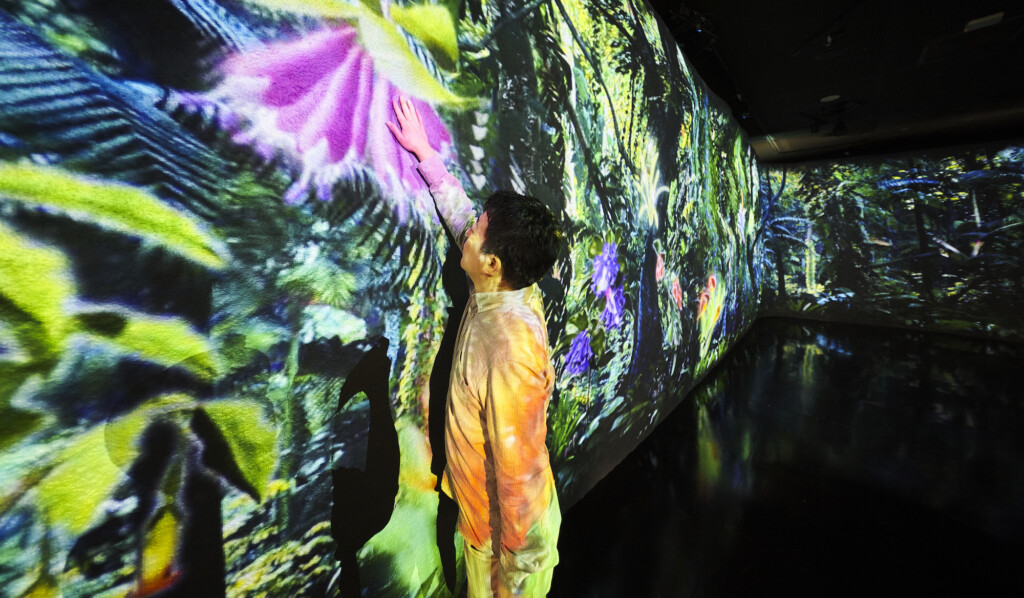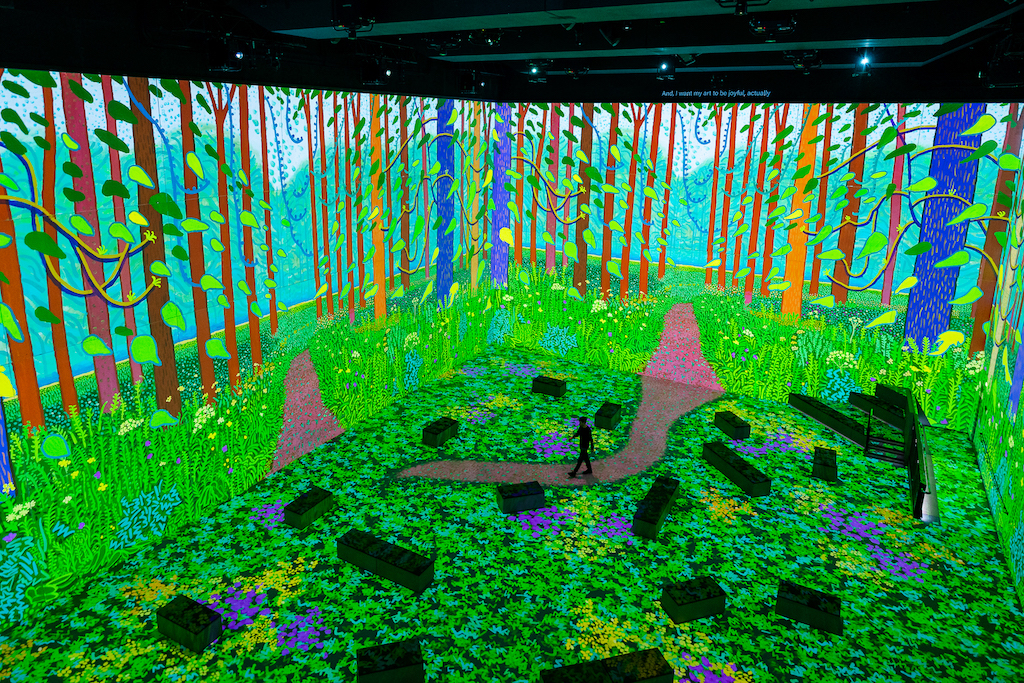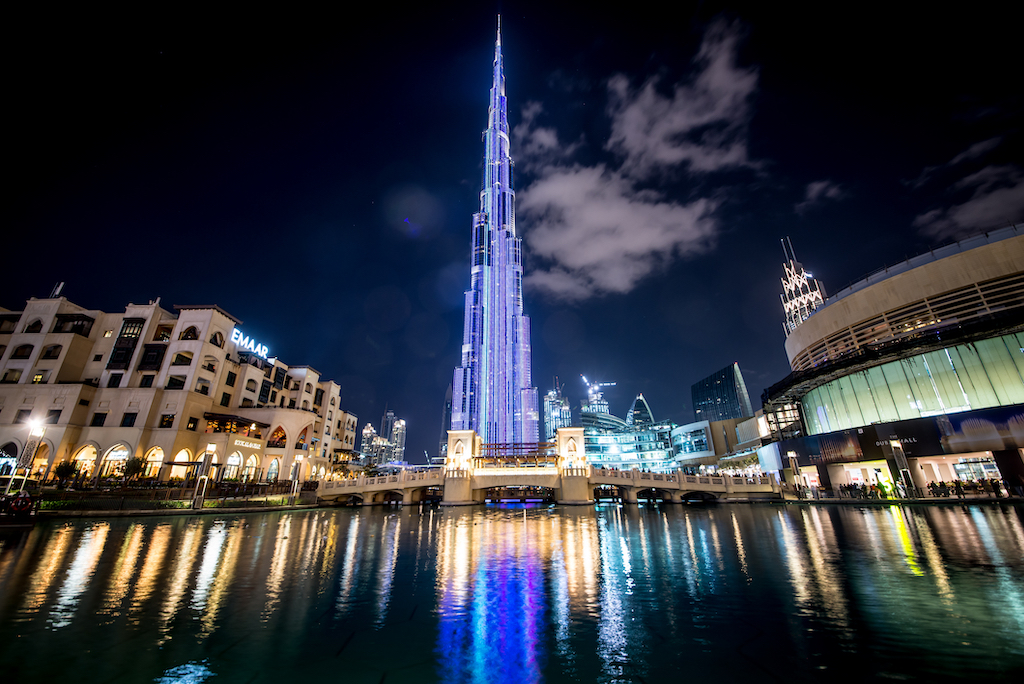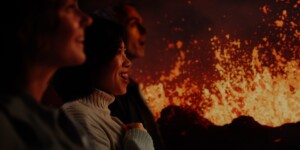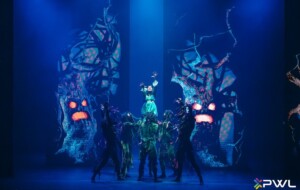Disguise is the industry-leading platform at the heart of a new era of visual experiences. Initially starting its journey in live events before moving into immersive experiences, as well as several other visual entertainment verticals, the company delivers comprehensive solutions and services, empowering creators to craft interactive and scalable experiences, and is redefining immersive entertainment worldwide.
With the growing complexity of location-based experiences (LBE), Disguise supports the creation of innovative attractions that seamlessly blend the physical and digital worlds.
Its innovative software, cloud tools, and media server solutions have been pivotal to some ambitious experiential projects, from Burj Khalifa’s LED displays to the 360-degree projection-mapped Al Wasl Dome at Dubai Expo 2020. Meanwhile, its creative and technical services team has helped clients, including Snap and MGM Grand, bring their experiences to life.
The platform is in use worldwide, with standout projects including The Hidden Forest in Singapore, the dynamic transformation of Top of the Rock at the Rockefeller Center in New York, and the visual spectacle of Blink Cincinnati, captivating millions of visitors.
Chief experience officer Alex Wills, head of location-based experiences Shae Langley, and innovation director Peter Kirkup share how Disguise is shaping the next generation of attractions, covering the challenges of designing immersive storytelling environments to the exciting future of real-time and AI-powered experiences.
From live events to LBE
Disguise has a strong heritage in live events and immersive entertainment. Speaking about how the company has evolved to serve the burgeoning LBE market, Wills says:
“Back then, the creative ambition and artistic vision meant we had to invent new technology to make ideas possible—and that innovation, in turn, unlocked even more creative potential. It started when we were part of United Visual Artists (UVA).
“The great thing about creativity is that it often demands new tools, and those tools expand what’s creatively possible. That’s exactly what happened when Massive Attack wanted to do data-driven visuals back in 2003. It seems straightforward today, but at the time, there was no viable solution. That need led to the creation of our technology.”
UVA was doing more than just concert visuals; it created site-specific art, augmenting physical settings with digital experiences.
“From the very beginning, our business had a dual role. A major milestone came during U2’s 2005 Vertigo Tour, where we worked with early LED technology. To fully realise the creative vision, we had to invent a real-time 3D visualiser—so the band and creative team could see the show evolving in real time. That innovation remains at the core of our product to this day.
“That became a hallmark of our software, enabling users to see not just a concept but final pixels and playouts.”
Eventually, the technology, originally called D3, split from UVA. “In parallel with live events, we were pioneering projection mapping, putting pixels into complex spaces and structures, scanning environments, and modelling building facades to create intricate projection-mapped experiences.”
Projection mapping and more
That technique still wows audiences today:
“We’ve applied similar techniques to iconic structures like the Burj Khalifa, where our best-in-class mapping tools scaled easily to the building’s massive surface.
“Unlike touring productions that must be portable and durable, fixed installations require commissioning and long-term operation. And our hardware and software were always designed to be rugged and scalable, adapting to the ambition of a project, whether it’s two projectors or 252, like Al Wasl Dome at Expo 2020.”
From the early days, the evolution into LBE felt natural. “Our DNA has always been about collaboration with creative partners who push boundaries, whether it’s projecting onto a unique or complex building, the world’s tallest skyscraper, or even sand dunes. Each challenge drives us to develop new technology to make these never-before-seen experiences possible.”
It is, however, a crowded market. Explaining how Disguise differentiates itself, Kirkup says:
“We offer an end-to-end solution. Many products in our sector see themselves as a technology piece, focusing solely on video playback and driving pixels to the screen. We start much earlier in the process. We’re both a pre-visualisation suite and a delivery platform, with a technical and creative services offering too.”
This allows the team to address challenges like stakeholder management, quality control, and ensuring the final experience looks precisely as intended, well before anyone steps on-site, as well as providing support during and after a project has launched.
“On-site time is expensive and complex, with multiple priorities competing for attention. Our approach has always been to shift as much of the production process ahead of time so that once on-site, the focus is purely on fine-tuning the final experience.”
The show must go on
For example, in projection mapping, traditional methods can take hours or even days to align projectors. In contrast, Disguise developed a camera-based alignment system that uses computer vision to calibrate multiple projectors quickly.
“This means stakeholders can focus on the outcome instead of spending hours staring at line-up grids while nervous creatives pace around waiting to see their content,” says Kirkup.
“Ultimately, everyone involved in a production wants the best possible outcome. Disguise ensures clients can visualise and iterate on their ideas before anything is built. Then, when they get on-site, the technical setup is handled swiftly so that the focus remains on perfecting the creative vision.
“That’s our true differentiator. It’s not just about individual features but an overarching approach woven into the company’s DNA.”
This extends beyond the initial production phase to support services as well, he adds: “Coming from a live events background, we have a ‘show must go on’ mentality. When the doors open at 7 p.m., the audience expects a flawless experience. It doesn’t matter what challenges arise.
“Our job is to make sure that the technology works and that the show goes on.”
Enhancing storytelling with Disguise
Disguise can help operators transform visitor attractions and enhance experiential storytelling.
“Coming from the live event space gives us a deep understanding of creative storytelling, which we bring into visitor attractions,” says Langley. “Experiential storytelling is a field we have worked in for 20 years.”
The David Hockney immersive experience at London’s Lightroom is a powerful example of how Disguise brings large-scale projection mapping to life, all in service of storytelling. It highlights how technology and creativity come together to craft truly immersive narrative experiences.
“What makes this unique is the complexity of integrating projection mapping with real-time content while ensuring perfect calibration across moving projections. Unlike other solutions specialising in only one aspect, whether virtual calibration, on-site adjustments, or pre-visualisation, Disguise combines all three into a single end-to-end workflow”
With Disguise, creators can seamlessly blend real-time content, interactive visuals, and spatial storytelling. “The platform acts as a digital twin, so creators can perfectly synchronise everything from projection mapping to LED installations.
“In leveraging real-time content technology, we can enable dynamic experiences that evolve based on audience interactions. This makes each visit unique and engaging.”
Kirkup adds: “We take care of all the visual elements and integrate with surrounding technologies. ‘Immersive’ is a big buzzword. But true immersion happens when all these systems work together.”
That means when someone walks into a space, the audio is perfectly timed with the video, sensing systems drive interactions, and real-time content renders dynamically.
“When you wave your arm, the content naturally responds. We sit at the centre of all this, acting as a data-wrangling tool that ensures everything stays in sync and communicates as it should while delivering high-fidelity visuals with precision and finesse.”
Enabling experiences that have never been done before
This level of integration transforms attractions from simple looping videos with background music into fully synchronised, cohesive experiences.
“But we also go beyond that, enabling experiences that have never been done before,” says Kirkup. “We integrate with real-time content engines to layer dynamic visuals over high-fidelity playback and even connect with platforms like Snapchat.
“That allows in-venue experiences, whether through projection or LED, to extend onto guests’ mobile devices, creating a connected, holistic experience. We’re always pushing boundaries, striving to deliver the ‘what’s next’, that one-up experience that makes an attraction stand out.”
The post-visit element is becoming increasingly important, too. “The rise of location-based experiences is largely fuelled by the ‘Instagram effect’. People want that unique, shareable moment that gets them likes and shares.
“We enhance this by making experiences hyper-personalised, whether through real-time tracking systems or interactive content that responds to guest movements. This kind of engagement drives social sharing and helps attractions sell more tickets. Ultimately, it strengthens the connection between visitors and the experience itself.”
Rising to the challenge
When it comes to some of the most significant challenges in delivering seamless, large-scale immersive experiences and how Disguises addresses these, Kirkup says:
“One of the biggest challenges we’ve seen is the rapid increase in screen resolution and the scale of display surfaces. Historically, a system with four or six projectors was considered sizable. Now, we’re dealing with projects using hundreds. For example, at Expo 2020 Dubai, we managed 252 4K projectors.
“The volume of pixels we process and the video data we generate have scaled exponentially, bringing media size and fidelity challenges. A 20,000-pixel-wide video is vastly larger than a 4K file, making it a different kind of media to handle. Synchronisation is also a significant challenge, as no single computer drives all that content; it requires a network of machines working as one.”
“Our solution abstracts that complexity, allowing users to think of it as a single video layer on a timeline, even if it’s being handled by 20, 30, or 50 computers in sync. We’ve also developed techniques to overcome the 16K barrier in computer graphics, where no texture can exceed 16K due to memory allocation limitations.”
Disguise enables customers to create surfaces up to 100,000 pixels wide by intelligently splitting and distributing content across machines for seamless playback.
“This removes workflow limitations and allows for higher fidelity, making experiences more immersive.”
Meeting evolving expectations with Disguise
When it comes to immersive attractions, audience expectations are constantly growing.
“We’re seeing a significant shift in audience expectations,” says Langley. “Particularly with Gen Z and Gen Alpha, who prioritise experiences over material possessions.”
As this generation enters the workforce with disposable income, there has been a surge in demand for highly interactive, gamified, and shareable experiences. Today’s audiences expect real-time engagement, personalisation, and integration with their digital lives.
Therefore, attractions can no longer rely solely on passive experiences or simple video playback. “Instead, they must create dynamic environments where visitors feel like active participants. Disguise is at the forefront of this shift, enabling real-time adaptive experiences that encourage social sharing and foster deeper emotional connections through cutting-edge technology.”
Another key trend is the need for refreshed content. Visitors may come once, but what compels them to return?
“The driving factor is often evolving content. Disguise enables this by providing a content-flexible platform that supports both interactive and real-time media, ensuring experiences remain fresh and engaging. Essentially, we serve as the backbone for attractions that continuously adapt to meet audience expectations.”
Making immersive technology more accessible
Many operators and designers face budget, space, or technical expertise constraints. Yet the Disguise platform is designed to make immersive technology more accessible.
“Disguise offers scalable, cost-effective solutions that cater to a broader range of attractions,” says Langley. “We recognise that not every venue has the budget of large-scale projects like the Sphere, so we’ve developed a more affordable hardware unit—the EX Range—while maintaining the full functionality of our software workflows.
“This opens up opportunities for a broader market that previously may not have had access to this level of technology.”
The company’s approach is built on modularity, allowing clients to start with a foundational system and expand as their creative ambitions grow. “Unlike many DIY-style solutions in the industry, our architecture is designed for long-term scalability, whether adding interactivity, increasing rendering power, or integrating new features, without requiring a complete reinvestment.”
For more accessibility, the platform is designed with intuitive, pre-configured workflows that reduce the learning curve for non-technical operators. It integrates with industry-standard content management and show control systems, enabling venues to adopt high-end immersive experiences without overhauling their infrastructure.
Through open APIs, venues can automate processes. Therefore, an immersive setup can be operated simply by pushing a button, eliminating the need for a full technical team.
“Additionally, our cloud-based tools allow remote calibration and management, minimising the need for on-site expertise.”
The versatility of the Disguise platform
Other notable projects, such as The Hidden Forest at Gardens by the Bay, Top of the Rock, and Blink Cincinnati, utilise Disguise’s technology in different ways.
“Each client within the immersive space has unique needs, and the versatility of Disguise allows us to meet those varied demands,” says Langley.
“For instance, The Hidden Forest utilises Disguise’s real-time content capabilities to create personalised, interactive journeys for audiences. The level of interactivity on display highlights how well our workflows can adapt to real-time content, ensuring each experience feels unique.”
On the other hand, Top of the Rock in New York shows how Disguise enhances the visitor experience through dynamic projection mapping. This project blends storytelling with the iconic cityscape.
“The challenge here was that the projectors are located on top of a subway station, and due to the slight movement of the projectors throughout the day, traditional calibration would be slow and repetitive, needing to be done daily. Disguise offers flexibility to recalibrate whenever needed to adapt to these shifts, ensuring precise projection mapping even in a changing environment.”
Meanwhile, Blink Cincinnati transformed urban spaces into interactive canvases with large-scale projection mapping. Disguise’s platform supported this by allowing multiple teams to project on different buildings across the city, creating a vibrant, collaborative art walk.
“Despite the diverse nature of the projections, Disguise ensures everything runs seamlessly. This highlights the platform’s ability to fit into existing structures and support expansive, location-based experiences.”
These examples demonstrate Disguise’s flexibility and reliability, whether in intimate, narrative-driven spaces or large-scale public installations.
“Our platform’s ability to support such diverse applications makes it a powerful tool for creative storytelling in immersive environments.”
Global trends
Immersive experiences are a global trend. In terms of some of the regional differences that the team is seeing, Wills says:
“The Middle East is seeing some of the most ambitious and visually engaging immersive projects. There’s a strong focus on creating more versatile multi-format venues that can host various events beyond sports or concerts.”
This trend reflects the region’s desire to create iconic, next-level experiences. “These projects often start from the ground up, allowing for more innovative design, but also require collaboration between architects, content creators, and tech experts to bring these visionary spaces to life.”
The rise of large-scale venues, such as the Sphere and the Intuit Dome, is influencing trends globally.
“However, there is a recognition that these projects need to be scalable and adaptable to different regions,” adds Wills. “The ambition of these spaces is clear, but the challenge remains to create a marriage of cutting-edge technology with compelling creativity.
“This means a shift toward collaborative working environments, where architects, content creators, and technologists work hand in hand, which hasn’t always been the case in traditional entertainment spaces and is why we have built out a brand new professional services division to help bridge these divides.
“China is another region that’s making incredible strides. The country is rapidly adopting XR studios and large-scale immersive projects. We recently worked two years in a row on CCTV China’s Set Sail events, which utilised Disguise xR solutions to deliver a new level of immersive experience. ”
While each region has unique characteristics, there is a common thread: the demand for highly interactive, engaging experiences that are more than just passive shows.
Powering next-gen LBE projects with Disguise
On the emerging innovations he believes will drive the next generation of LBE projects, Kirkup says:
“We’re very focused on the potential of AI and how it can drive the evolution of immersive experiences. Innovation is a key part of our role, and we’re actively exploring how AI can contribute to real-time content generation and enhance user interactions.”
At Disguise, we give creatives the flexibility to choose the right approach for each moment through video, real-time content, or on-the-fly generation. The real power lies in having the freedom to make creative decisions based on the moment, which we strive to offer.
This could lead to highly personalised content experiences, especially in location-based attractions, where visitors might want a more customised experience. “With the increasing expectation for real-time, responsive content from platforms like Instagram and Snapchat, it’s our responsibility to bring that level of interactivity and personalisation into the professional space.”
The future of content is undoubtedly evolving towards AI-generated media. However: “AI is not a one-size-fits-all solution but a tool. It can assist in numerous ways, from speeding up workflows to providing real-time support and troubleshooting. AI’s role is more about enabling creativity and efficiency, allowing teams to focus on the creative side.”
While all these technological tools support the guest experience, sometimes the most impactful moments come from simplicity:
“Sometimes, a single colour or a minimalistic design choice can have a powerful impact on the story being told. At Disguise, we give creatives the flexibility to choose the right approach for each moment through video, real-time content, or on-the-fly generation. The real power lies in having the freedom to make creative decisions based on the moment, which we strive to offer.”
What’s next for Disguise?
Looking ahead to the role Disguise can play in shaping this future, Wills says:
“Location-based experiences hold immense potential, especially as we integrate real-time technologies with emerging tools like generative AI. The challenge, however, lies in making these technologies easier to use and more accessible for content creators. That’s where Disguise comes in.
“Our software tool, RenderStream, enables any engine or content to seamlessly integrate into our systems, whether on screens or projections. This provides the flexibility to easily incorporate existing engines like Unreal Engine with new engines and renders, as well as entirely new AI technologies.
“By making these processes more straightforward, we empower content creators to focus on crafting compelling experiences without getting bogged down by complex integration challenges.”
Interactivity and personalisation remain key areas of opportunity. Creating personal, interactive experiences for mass audiences can be challenging, especially when dealing with large groups. “However, by leveraging tools like ambient sound recognition (for example, measuring the loudest section in a theatre), we can create more dynamic and engaging environments.
“This approach, which utilises spatial computing, allows for passive, contextually aware interactions rather than relying on direct user input.”
Disguise aims to be the backbone technology that powers these experiences. “Our platform enables the seamless integration of various tools like AR, AI, or audio-visual enhancements to create rich, personalised interactions.”
Ultimately, the role of Disguise is to help bridge the gap between cutting-edge technology, incredible creativity and their practical application, enabling immersive experiences that are not only personalised and interactive but also scalable and easy to manage.
